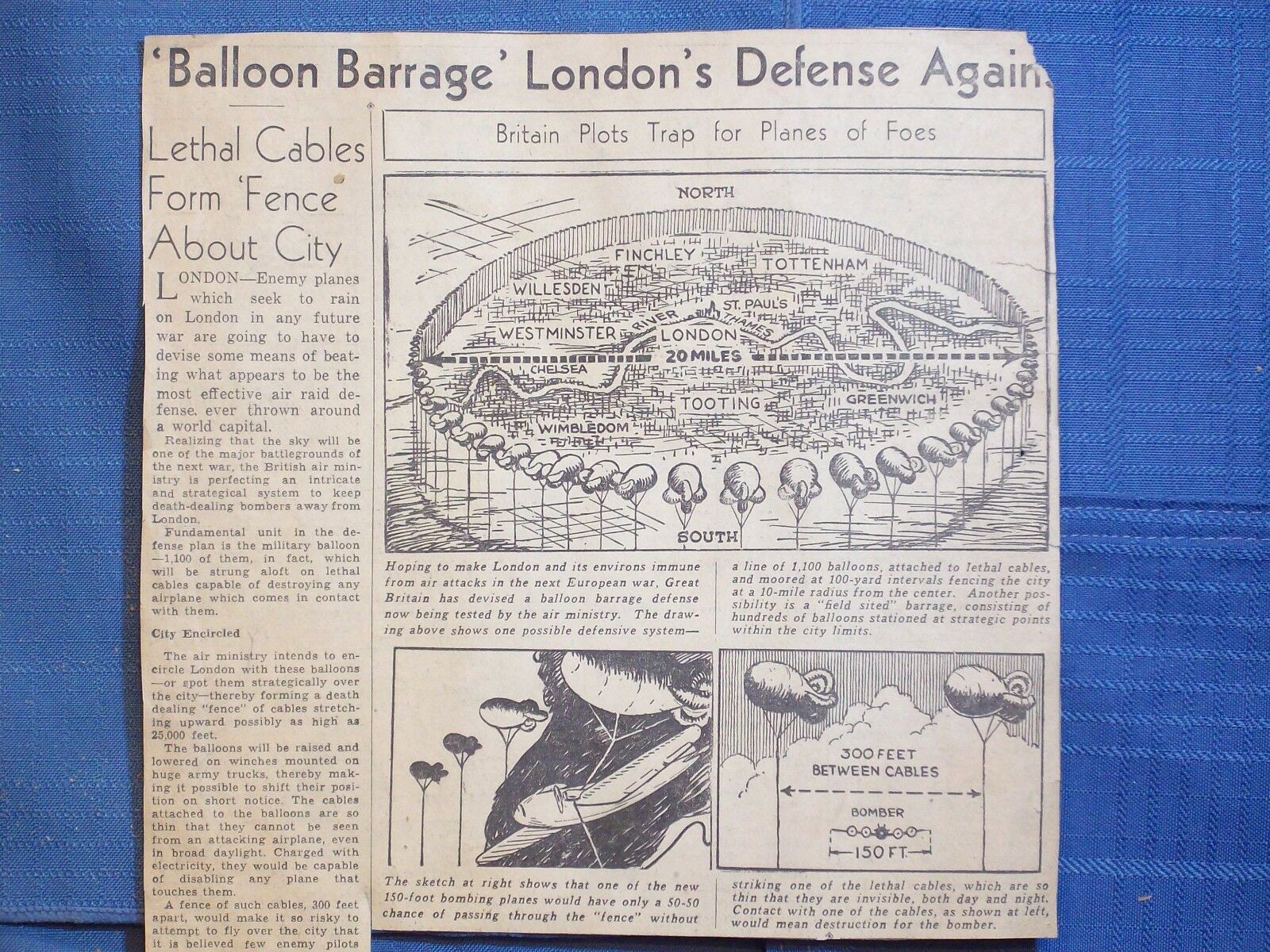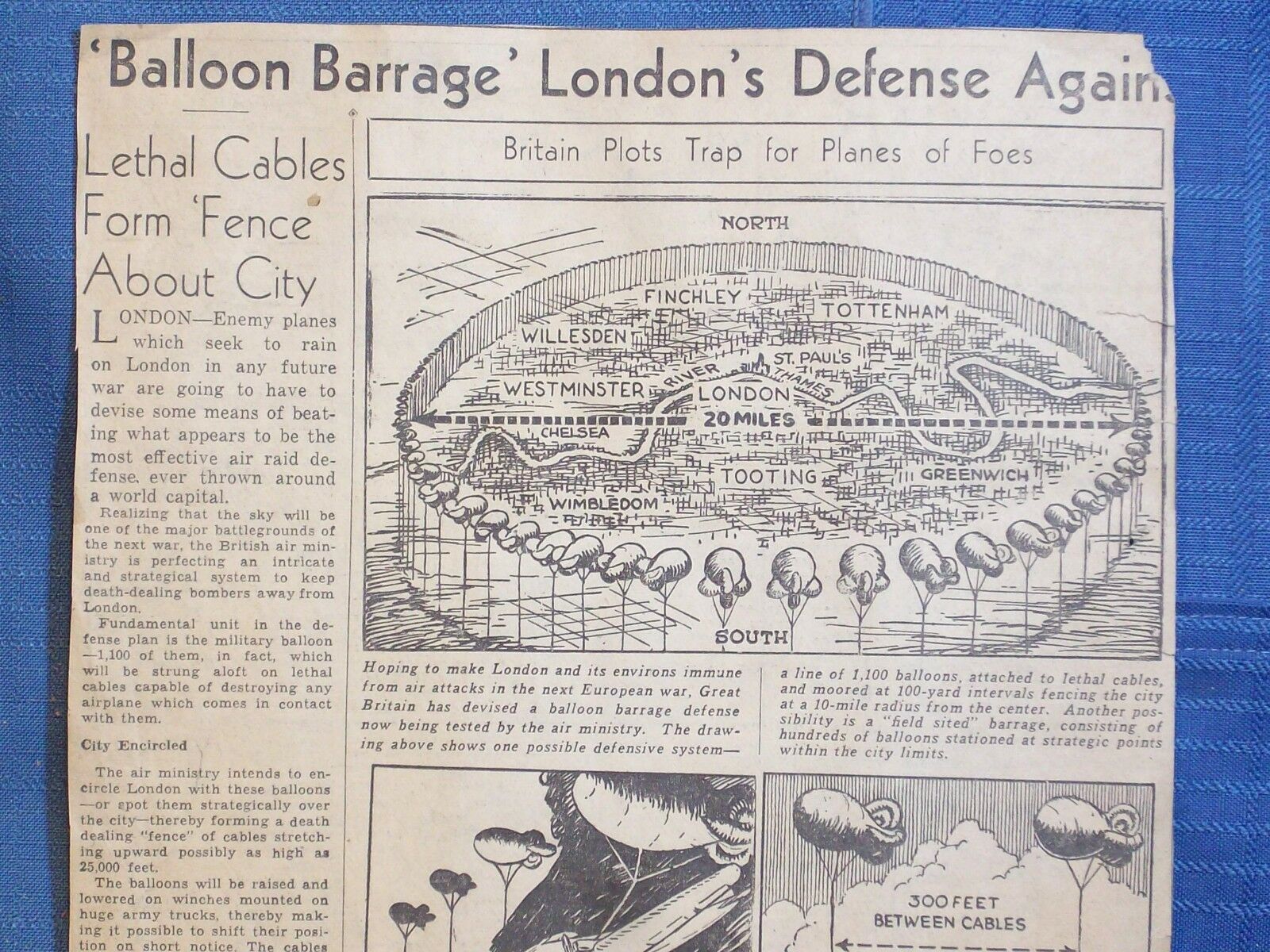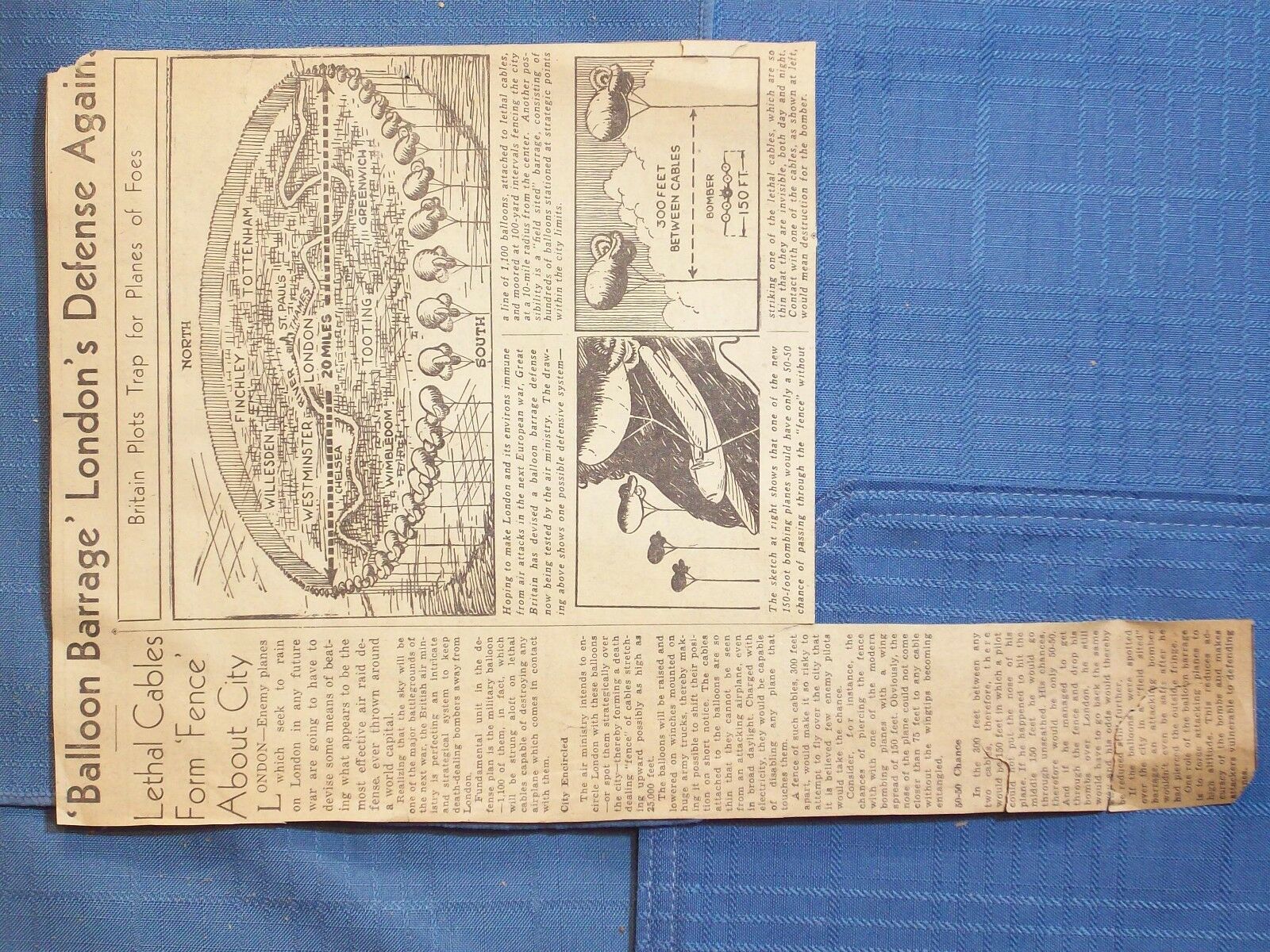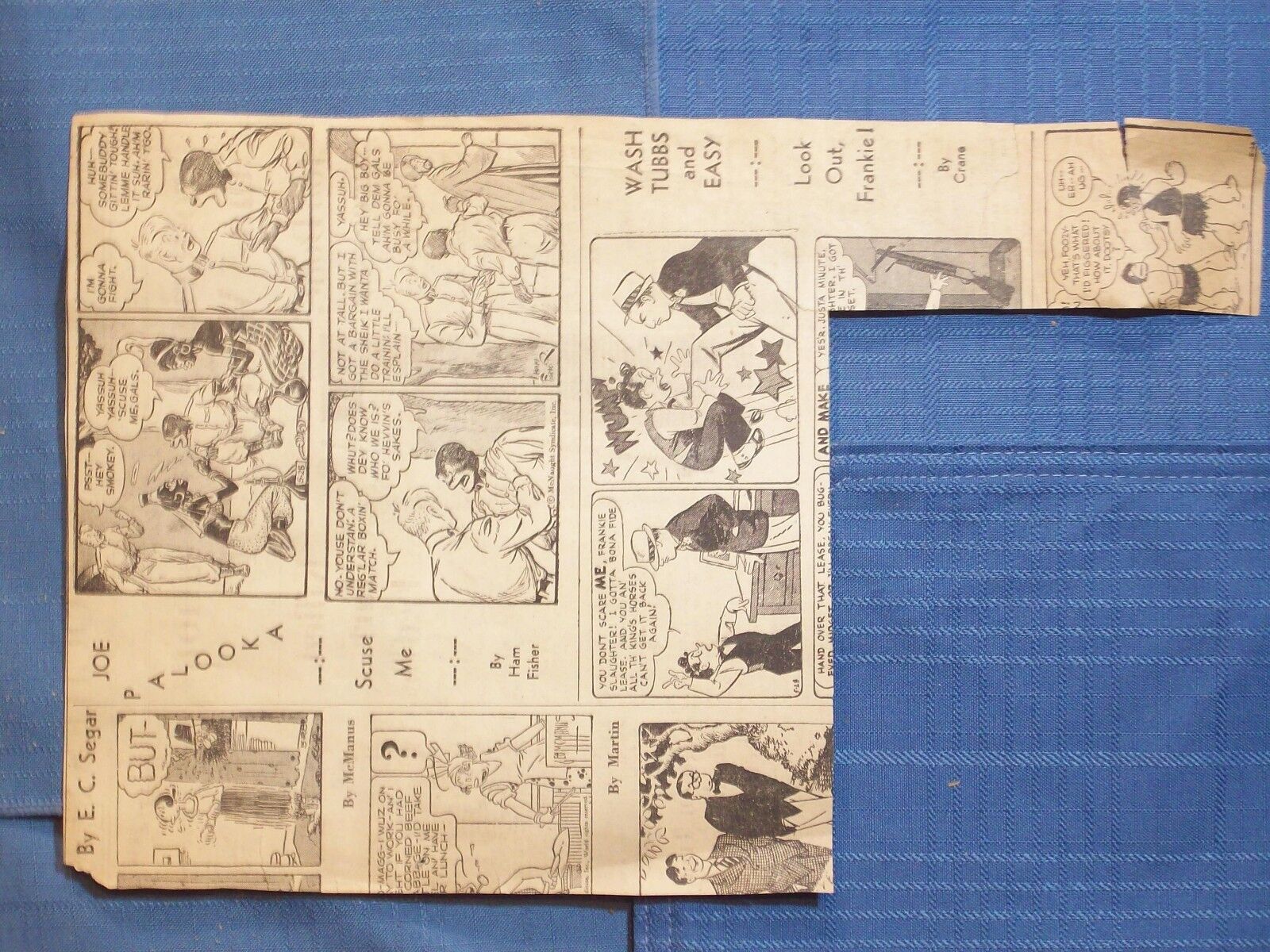-40%
NEWSPAPER COMIC DEMOCRAT AND CHRONICLE ROCHESTER NY OCT. 20 1912 CLUMSY CLAUDE C
$ 4.22
- Description
- Size Guide
Description
NEWSPAPER ARTICLE WWII BALLOON BARRAGE LONDON’S DEFENSE AGAINST ENEMY BOMBERS LETHAL CABLES FORM FENCE ABOUT CITYUSED: GOOD SHAPE
(SAME PHOTOGRAPH IS IN A MAY 25, 1938 PAPER HOPE STAR FROM HOPE ARKANSAS)
FINCHLEY, TOTTENAM, WILLESDEN, WESTMINSTER, CHELSEA, TOOTING, WIMBLEDOM, TOOTING, GREENWICH, THAMES RIVER, ST. PAUL’S
HOPING TO MAKE LONDON AND ITS ENVIRONS IMMUNE FROM AIR ATTACKS IN THE NEXT EUROPEAN WAR, GREAT BRITAIN HAS DEVISED A BALLOON BARRAGE DEFENSE NOW BEING TESTED BY THE AIR MINISTRY. THE DRAWING ABOVE SHOWS ONE POSSIBLE DEFENSIVE SYSTEM – A LINE OF 1,100 BALLOONS ATTACHED TO LETHAL CABLES, AND MOORED AT 100-YARD INTERVALS FENCING THE CITY AT A 1—MILE RADIUS FROM THE CENTER. ANOTHER POSSIBILITY IS A “FIELD SITED” BARRAGE, CONSISTING OF HUNDREDS OF BALLOONS STATIONED AT STRATEGIC POINTS WITHIN THE CITY LIMITS.
THE SKETCH AT RIGHT SHOWS THAT ONE OF THE NEW 150-FOOT BOMBING PLANES WOULD HAVE ONLY A 50-50 CHANCE OF PASSING THROUGH THE “FENCE WITHOUT STRIKING ONE OF THE LETHAL CABLES, WHICH ARE SO THIN THAT THEY ARE INVISIBLE, BOTH DAY AND NIGHT. CONTACT WITH ONE OF THE CABLES, AS SHOWN AT LEFT, WOULD MEAN DESTRUCTION FOR THE BOMBER.
LONDON – ENEMY PLANES WHICH SEEK TO RAIN ON LONDON IN ANY FUTURE WAR ARE GOING TO HAVE TO DEVISE SOME MEANS OF BEATING WHAT APPEARS TO BE THE MOST EFFECTIVE AIR RAID DEFENSE EVER THROWN AROUND A WORLD CAPITAL.
REALIZING THAT THE SKY WILL BE ONE OF THE MAJOR BATTLEGROUNDS OF THE NEXT WAR, THE BRITISH AIR MINISTRY IS PERFECTING AN INTRICATE AND STRATEGICAL SYSTEM TO KEEP DEATH-DEALING BOMBERS AWAY FROM LONDON.
FUNDAMENTAL UNIT IN THE DEFENSE PLAN IS THE MILITARY BALLOON – 1,100 OF THEM, IN FACT WHICH WILL BE STRUNG ALOFT ON LETHAL CABLES CAPABLE OF DESTROYING ANY AIRPLANE WHICH COMES IN CONTACT WITH THEM.
CITY ENCIRCLED
THE AIR MINISTRY INTENDS TO ENCIRCLE LONDON WITH THESE BALLOONS – OR SPOT THEM STRATEGICALLY OVER THE CITY – THEREBY FORMING A DEATH DEALING “FENCE” OF CABLES STRETCHING UPWARD POSSIBLY AS HIGH AS 25,000 FEET.
THE BALLOONS WILL BE RAISED AND LOWERED ON WINCHES MOUNTED ON HUGE ARMY TRUCKS, THEREBY MAKING IT POSSIBLE TO SHIFT THEIR POSITION ON SHORT NOTICE. THE CABLES ATTACHED TO THE BALLOONS ARE SO THIN THAT THEY CANNOT BE SEEN FROM AN ATTACKING AIRPLANE, EVEN IN BROAD DAYLIGHT. CHARGED WITH ELECTRICITY, THEY WOULD BE CAPABLE OF DISABLING ANY PLANE THAT TOUCHES THEM.
A FENCE OF SUCH CABLES, 300 FEET APART, WOULD MAKE IT SO RISKY TO ATTEMPT TO FLY OVER THE CITY THAT IT IS BELIEVED FEW ENEMY PILOTS WOULD TAKE THE CHANCE.
CONSIDER, FOR INSTANCE, THE CHANCES OF PIERCING THE FEINCE WITH ONE OF THE MODERN BOMBING PLANES WITH A WING SPREAD OF 150 FEET. OBVIOUSLY THE NOSE OF THE PLANE COULD NOT COME CLOSER THAN 75 FEET TO ANY CABLE WITHOUT THE WINGTIPS BECOMING ENTANGLED.
50-50 CHANCE
IN THE 300 FEET BETWEEN ANY TWO CABLES, THEREFORE, THERE WOULD BE 150 FEET IN WHICH A PILOT COULD NOT PUT THE NOSE OF HIS PLANE. IF HE HAPPENED TO HIT THE MIDDLE 150 FEET HE WOULD GO THROUGH UNSCATHED. HIS CHANCES, THEREFORE WOULD BE ONLY 50-50. AND IF HE MANAGED TO GET THROUGH THE FENCE AND DROP HIS BOMBS OVER LONDON, HE STILL WOULD HAVE TO GO BACK THE SAME WAY AND HIS ODDS WOULD THEREBY BE REDUCED STILL FURTHER.
IF THE BALLOONS WERE SPOTTED OVER THE CITY IN A “FIELD SITED” BARRAGE, AN ATTACKING BOMBER WOULDN’T EVEN BE ___ AFTER HE HAD PIERCED THE OUTSIDE FRINGE.
ONE ROLE OF THE BALLOON BARRAGE IS TO FORCE ATTACKING PLANES TO HIGH ALTITUDE. THIS REDUCES ACCURACY OF THE BOMBS AND MAKES ATTACKERS VULNERABLE TO DEFENDING PLANES.
BACK SIDE COMICS JOE PALOOKA
SCUSE ME
WASH TUBBS AND EASY
LOOK OUT FRANKIE
A CHARACTER THAT LOOKS LIKE OLIVE OIL
First World War
France, Germany, Italy and the United Kingdom used barrage balloons in the First World War. Sometimes, especially around London, several balloons were used to lift a length of "barrage net", in which a steel cable was strung between the balloons and many more cables hung from it. These nets could be raised to an altitude comparable to the operational ceiling (14,764 ft/ 4,500 m) of the bombers of that time period. By 1918 the barrage defences around London stretched for 50 miles (80 km), and captured German pilots expressed great fear of them.
[1]
Second World War
Landing ships putting cargo ashore on one of the invasion beaches during the Battle of Normandy. Note the barrage balloons.
Balloons could be launched from specialised vehicles.
In 1938 the British Balloon Command was established to protect cities and key targets such as industrial areas, ports and harbours. Balloons were intended to defend against dive bombers flying at heights up to 5,000 feet (1,500 m), forcing them to fly higher and into the range of concentrated anti-aircraft fire—anti-aircraft guns could not traverse fast enough to attack aircraft flying at low altitude and high speed. By the middle of 1940 there were 1,400 balloons, a third of them over the London area.
While dive-bombing was a devastatingly effective tactic against undefended targets, such as Guernica and Rotterdam, dive-bombers were very vulnerable to attack by fighter aircraft while performing a dive, and their use in this role by Germany against the UK with its effective Royal Air Force was rapidly discontinued. Balloons proved to be of little use against the German high-level bombers with which the dive-bombers were replaced, but continued to be manufactured nonetheless, until there were almost 3,000 in 1944. They proved to be mildly effective against the V-1 flying bomb, which usually flew at 2,000 feet (600 m) or lower but had wire-cutters on its wings to counter balloons. 231 V-1s are officially claimed to have been destroyed by balloons.
[2]
The British added two refinements to their balloons, "Double Parachute Link" (DPL) and "Double Parachute/Ripping" (DP/R). The former was triggered by the shock of an enemy bomber snagging the cable, causing that section of cable to be explosively released complete with parachutes at either end; the combined weight and drag bringing down the aircraft. The latter was intended to render the balloon safe if it broke free accidentally. The heavy mooring cable would separate at the balloon and fall to the ground under a parachute; at the same time a panel would be ripped away from the balloon causing it to deflate and fall independently to the ground.
[3]
In January 1945, during Royal Navy Fleet Air Arm raids on the Palembang oil refineries, the British aircrews were surprised by massive use of barrage balloons in the Japanese defences. These were spherical and smaller than the British type. One Grumman Avenger was destroyed, and crew killed, from striking a balloon cable.
[4]
Combined items reduces total shipping cost. I will combine into a 1 package weight shipping.
I use a sheet of cardboard so these don't get bent.












